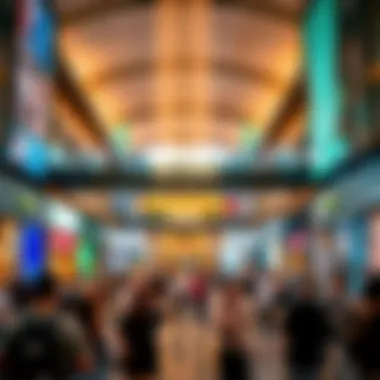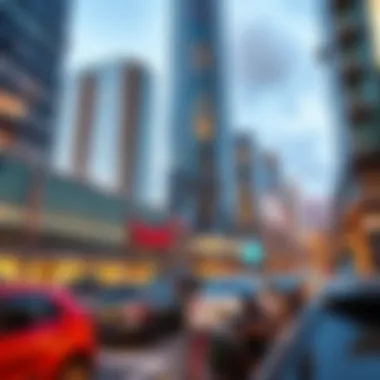Exploring the WTC Mall: A Comprehensive Overview


Intro
The WTC Mall stands as a testament to Dubai's architectural ambition and commercial vibrancy. Nestled in the heart of the city, this shopping hub is not simply a place to shop, but a thoroughfare of activity that reflects the pulse of urban life. With its iconic design and diverse retail options, the mall draws both locals and tourists alike, enriching the fabric of the city's day-to-day interactions.
Significance of the WTC Mall
Situated adjacent to the World Trade Centre, the mall isn't just about commerce; it plays a crucial role in the economic landscape of Dubai. Investors looking at this area observe not just the physical structure but also the broader implications of such a space. The mall symbolizes a convergence of retail, culture, and business—a microcosm of what Dubai represents: innovation and opportunity.
Contextual Framework
As we delve into the various facets of the WTC Mall, we will touch upon its architectural elegance, retail dynamics, and the visitor experience. This examination will also illuminate current market trends within Dubai's real estate sector, particularly as they pertain to commercial spaces like the WTC Mall.
The subsequent sections will guide investors, property enthusiasts, and urban planners through a detailed overview, providing insights that are both informative and actionable. With the burgeoning growth of Dubai's real estate market, understanding the unique offerings of the WTC Mall can equip stakeholders to navigate the complexities of investment and development in this iconic city.
Prolusion to WTC Mall
The WTC Mall stands as a significant beacon within the bustling metropolis of Dubai, offering a marriage of modernity and commerce. Its creation is not just a response to the growing demand for retail and entertainment spaces but also serves a larger purpose in the context of urban growth and lifestyle. For investors, homebuyers, agents, developers, and analysts, understanding this landmark is crucial for grasping the ever-evolving landscape of Dubai's real estate and economic dynamics. The mall encapsulates the essence of a global city, blending commerce with culture and leisure.
Historical Context
In exploring the roots of the WTC Mall, one must consider Dubai’s rapid transformation over the past few decades. Originally a modest trade port, Dubai has grown into a global trading hub. The idea of the mall emerged in the context of not just economic expansion but also as an answer to the need for modern shopping experiences that reflect shifting consumer preferences. The mall incorporates architectural elements that tell a story of progress while providing the facilities that modern shoppers expect.
The construction of the WTC Mall was particularly timely. As Dubai hosted various international events, including EXPO 2020, the need for a shopping destination that could cater to tourists and locals alike became more urgent. This development is not merely a commercial venture but also a symbol of Dubai's aspirations on the world stage.
Purpose and Vision
At its core, the purpose of the WTC Mall can be summed up as creating a distinctive shopping environment, where international brands meet local flair. The vision behind it extends beyond just retail, aiming to create a community hub that enhances visitors’ experiences. With features like entertainment zones, fine dining options, and cultural exhibitions, the mall seeks to serve as a one-stop destination for both shopping and leisure.
The leadership behind this venture envisions the mall as a catalyst for economic growth, encouraging entrepreneurship and boosting local markets. For homebuyers and investors, this intent translates to opportunities not just in retail but in property investments around the mall.
"The WTC Mall is not just a place to shop; it is an experience that reflects Dubai’s commitment to innovation and quality of life."
By positioning itself as an anchor for the community, the mall is set to achieve long-term sustainability and attract a diverse range of visitors. It represents the harmony between commerce, entertainment, and cultural engagement that defines Dubai today.
In summary, comprehending the WTC Mall's inception and aspirations provides valuable insight into its role in Dubai's urban fabric. As we venture deeper into its architectural marvels and commercial offerings, the importance of this landmark only becomes more pronounced, revealing its multifaceted impact on the city and beyond.
Architectural Overview
The architectural overview of the WTC Mall serves as a backbone for understanding its significance in Dubai’s urban fabric. An effective blend of aesthetic appeal and functionality is critical in appealing to diverse consumers while maintaining operational efficiency. The design informs how visitors interact with the space, enhancing their overall experience.
Design Elements
Exterior Facade
The exterior facade of the WTC Mall stands out like a beacon, showcasing contemporary design concepts while harmonizing with the city's cultural essence. It presents a striking visual identity, characterized by its sleek lines and ample glass. The generous use of natural light permeates through the building, which not only reduces reliance on artificial lighting but also creates an inviting atmosphere. This choice of design is beneficial for those seeking a modern yet culturally resonant shopping experience.
A unique feature of the facade is its ability to reflect the surrounding cityscape, blurring the lines between the mall and its environment. This visual connection enhances the feeling that shoppers are part of a larger urban narrative. However, the extensive glass surfaces also come with challenges in terms of heat management and glare, which needs to be meticulously addressed.
Interior Layout
The interior layout of the WTC Mall is crafted with visitor flow in mind. It aims to ensure that each shopping experience feels seamless and engaging. One key characteristic of the layout is its open-plan design, allowing shoppers to navigate easily amongst various retail outlets and dining options, encouraging impulse visits.
A standout aspect is the strategic placement of anchor stores, which draw in foot traffic and ensure a vibrant atmosphere throughout the mall. Though this creates a dynamic retail environment, the presence of wide walkways and rest areas helps maintain a sense of comfort amidst the crowd. Unfortunately, without careful management, high footfall times could lead to congestion in certain areas.
Landscaping


Landscaping plays a critical role in enhancing the overall aesthetic and sensory experience of the WTC Mall. Integrating green spaces within an urban setting not only beautifies the environment but also provides a respiratory retreat for visitors. One of the key features is the incorporation of green terraces, which create a natural contrast to the modern architectural elements, fostering an eco-friendly ambiance.
Sustainable landscaping practices are evident through the choice of local flora, minimizing water consumption while supporting the region's biodiversity. This unique feature not only beautifies the mall but also serves educational purposes, showcasing native plants that contribute to the local ecosystem. However, maintaining these landscaped areas requires ongoing attention and resources, which could present challenges for mall management.
Sustainability Initiatives
Moving further, the WTC Mall has committed to sustainability initiatives that align with global efforts to mitigate environmental impact. These initiatives focus on energy efficiency, waste reduction, and community engagement. Integrating such practices is especially appealing to environmentally-conscious consumers, thus broadening the mall's appeal. Emphasizing sustainability can encourage potential investors who value long-term viability in commercial properties.
In addition to reducing the ecological footprint, these initiatives bolster the mall's image and attract a niche demographic that prioritizes green practices.
"A commitment to sustainability isn’t just an option; it’s a necessity in today’s global marketplace."
By marrying architectural vision with sustainability initiatives, the WTC Mall not only establishes itself as a landmark but also contributes positively to Dubai's urban environment. This combination enhances visitor satisfaction while promoting economic sustainability, making it a prime consideration for real estate investors and urban planners alike.
Commercial Offerings
Commercial offerings are at the heart of the WTC Mall, playing a significant role in attracting visitors and contributing to the overall atmosphere of the venue. The combination of retail, dining, and entertainment options creates a vibrant environment that caters to a variety of demographics from tourists to local residents. By understanding the diverse commercial landscape, investors can better appreciate the mall's potential within Dubai's competitive market.
Retail Outlets
Luxury Brands
Luxury brands featured in the WTC Mall serve not just to provide goods, but to enhance the mall's prestige and appeal. These brands are often synonymous with quality and exclusivity, drawing discerning shoppers eager for high-end fashion and accessories. The unique characteristic of luxury brands lies in their ability to evoke aspiration, making them a popular choice for high-profile visitors and affluent locals alike. The advantage of having these brands present is clear: they help position the WTC Mall as a premier shopping destination, therefore attracting foot traffic that boosts the overall commerce within the space.
Local Boutiques
Local boutiques represent a gem in the retail landscape of WTC Mall. They offer unique products that reflect the local culture and craftsmanship, providing something distinct from mass-produced items found in typical retail chains. The character of these boutiques lies in their personalized service and innovative offerings that cater specifically to local tastes. This aspect can be seen as beneficial for the city's cultural identity while allowing visitors a taste of local heritage. However, the challenge for these boutiques often lies in competing with larger brands for visibility and foot traffic.
Popular Chains
Popular chains are integral to WTC Mall's accessibility, catering to the everyday shopper. These outlets ensure that the mall attracts a broad audience, including families and budget-conscious shoppers. Well-known brands often bring brand loyalty and reassurance in quality, making them a familiar and preferred choice for many. Their unique feature lies in the consistent experience they offer, though their presence might sometimes overshadow local businesses, providing a dual-edged sword for the mall's commercial ecosystem.
Dining Experiences
Cafes
Cafes within the WTC Mall provide a casual space for visitors to unwind. Their appeal lies in the relaxed atmosphere and the opportunity for social interactions. With a variety of beverage options and light bites, they cater to shoppers looking for a quick break. A unique feature of these cafes is their aesthetic charm, often designed to create inviting spaces perfect for Instagram-worthy moments. However, the challenge they face is competing with more substantial dining options that draw larger crowds.
Fine Dining
Fine dining establishments elevate the WTC Mall's culinary landscape by offering gourmet dishes and an upscale dining experience. They contribute significantly to the mall's reputation as a high-end destination. The exquisite decor and personalized service define the essence of fine dining, making it a perfect choice for special occasions or business meetings. However, the high cost may deter some potential diners, creating limitations on the demographics they attract.
Fast Food Options
Fast food options in the WTC Mall cater to the practical needs of visitors looking for a quick meal. This segment is inherently popular, as it provides convenience and affordability—especially attractive to families or individuals on the go. The unique aspect of fast food is that it tends to draw larger crowds with its widespread recognition and often familiar tastes. However, critics point out that these options may lack the unique dining experiences that fine dining and cafes offer, leading to a somewhat bland perception in a mall known for its diversity.
Entertainment Facilities
Cinemas
Cinemas located within the WTC Mall enhance the overall entertainment value, providing a variety of films ranging from blockbuster hits to independent films. This diversity attracts a wide audience, ensuring consistent foot traffic throughout the week. The characteristic that sets these cinemas apart is the state-of-the-art technology and comfortable seating arrangements, making for an enjoyable viewing experience. However, with streaming services booming, cinemas face increased competition, challenging them to keep their offerings fresh and appealing.
Gaming Zones
Gaming zones offer a modern twist to traditional mall entertainment. They cater to tech-savvy youths looking for interactive experiences through virtual reality and gaming options. This unique feature can serve to not only engage younger audiences but also attract families as children that enjoy these zones often bring along their parents. However, the upkeep and continual introduction of new technology can pose financial challenges for ongoing success.
Event Spaces


Event spaces within the WTC Mall serve as multipurpose venues that can host a range of functions from corporate events, workshops to expos. Their flexibility allows for various gatherings, bringing in diverse crowds. The characteristic feature of these spaces is their ability to adapt to different themes and requirements, making them a beneficial choice for businesses seeking exposure. On the flip side, the success of such spaces can rely heavily on strategic marketing and event planning, which can sometimes overextend resources.
Visitor Demographics
Understanding visitor demographics is crucial in grasping the essence of the WTC Mall's role in Dubai's vibrant marketplace. This section delves into the various facets that shape who comes through the mall's doors and why it matters for investors, retailers, and city planners. The demographics not only reflect the direct audience but also speak volumes about potential market shifts and opportunities that might arise, making it an integral part of the overall narrative.
Target Audience
The WTC Mall attracts a diverse crowd, from affluent tourists to local families searching for a day out. Each group exhibits distinct shopping preferences and behaviors. On one hand, luxury tourists are drawn to high-end brands like Gucci and Prada, seeking the latest fashions and exclusive pieces. These visitors often come from countries with strong economic backgrounds, such as the United States, Europe, and even nearby Gulf nations.
On the other hand, there are local families who frequent the mall's more affordable retail outlets. Stores such as Carrefour cater to their grocery needs while PG-13 cinema options draw kids and teenagers alike. This creates a balanced ecosystem where financial spending varies widely, creating multiple revenue streams for the mall.
The millennial crowd has also made its presence felt, not just in numbers, but in how they engage with the mall. Social media influences their buying habits significantly, propelling trends such as sustainability and ethical consumption. For instance, brands that promote eco-friendly practices are more likely to catch their eye. This shifting consumer sentiment underlines the importance of understanding the target demographic in order to position offerings effectively.
Visitor Trends
When diving into visitor trends, it's enlightening to analyze periods of peak attendance. Generally, weekends and holidays witness a surge in foot traffic. During these times, promotional campaigns run by the mall's management tend to amplify visitor turnout, boosting sales for retailers.
In recent years, there’s been a noticeable uptick in festival participation and seasonal shopping events. These gatherings, which often include cultural performances or food festivals, not only enhance the visitor experience but also attract individuals who might not normally frequent the mall.
Additionally, data reflects a growing interest in online-to-offline shopping experiences. Visitors research products online but prefer making the final purchase on-site to assess quality firsthand or enjoy the tactile experience of shopping. This has led to investments in tech for retailers, making information accessible through apps or QR codes within the mall as well.
In summary, the intricacies of visitor demographics and trends at the WTC Mall reveal valuable insights for stakeholders. The audience is multifaceted, and their spending habits, influenced by cultural trends and technological advancements, underscore the dynamic nature of retail in Dubai. As such, understanding these elements can greatly benefit investors, developers, and marketers alike.
“A mall’s success hinges not merely on its design but on how well it understands and serves its visitors.”
For further reading on economic patterns affecting visitor behaviors, you may explore Wikipedia or recent studies published in journals available at Britannica.
Economic Impact
The economic impact of the WTC Mall extends beyond mere numbers and statistics; it weaves into the very fabric of Dubai's urban economy. While it's undeniable that the mall offers a slew of retail and dining options, its significance is largely rooted in its role as a catalyst for economic development in the region.
Local Economy
The WTC Mall stands as a beacon for local commerce, attracting both residents and international visitors alike. This diverse foot traffic not only boosts sales for retailers but also enhances the appeal of the surrounding area as a prime shopping destination. With a mix of high-end brands and unique local boutiques, the mall embodies a blending of cultures and lifestyles, stimulating consumer spending that transcends traditional shopping behaviors.
Several factors contribute to this enriching dynamic:
- Increased Tourism: The WTC Mall attracts tourists from all over the globe, eager to experience its offerings. This influx contributes significantly to local businesses and elevates Dubai’s status as a major tourist location.
- Support for Local Businesses: The presence of local boutiques within the mall helps them tap into a larger customer base, giving them a fighting chance in a fiercely competitive market.
- Community Engagement: Events and activities hosted by the mall foster a sense of community, drawing local residents in and encouraging them to support the surrounding businesses as well.
The idea is, when the WTC Mall thrives, the local economy benefits in various ways. Higher sales means more tax revenue for infrastructure development and public services, fueling further growth.
Employment Opportunities
The establishment of the WTC Mall has opened a floodgate of employment opportunities, thereby enhancing the livelihoods of many within the community. From retail jobs to management positions, the spectrum of employment options available is vast. This increase in employment contributes to a more robust economic climate in the area.
- Diversity of Roles: The mall offers various roles, which range from sales assistants to event coordinators, catering to a wide range of skills and qualifications. This diversity provides opportunities for individuals from different backgrounds.
- Professional Development: Many retailers offer training programs that help employees advance their skills, which can lead to upward movement in their careers. This aspect not only benefits the employees but also enhances the overall service quality at the mall.
- Job Creation Metrics: Local governments often use employment statistics as indicators of economic health. With WTC Mall creating a multitude of jobs, it positively influences economic indicators, presenting a more favorable business environment.
Investing in the WTC Mall means investing in the community and its future, as increased employment leads to stronger consumer spending, which is the bedrock of any thriving economy.
The economic ripple effect initiated by the WTC Mall is manifest in how it supports not just local businesses, but also uplift the entire community by providing jobs and a platform for economic expansion.
Investment Potential
The WTC Mall stands as a beacon in Dubai's bustling real estate market, drawing attention from investors far and wide. It’s not just a stylish centerpiece; its investment potential is deeply intertwined with the fabric of Dubai’s overall economic landscape. As the city continues to evolve, those who are paying close attention will find that the mall offers substantial long-term benefits, making it a prime candidate for investment.


Real Estate Dynamics
In the realm of real estate, location is king, and WTC Mall sits snugly in a strategic hub where everything is happening. Surrounded by major commercial and residential developments, it creates a tapestry of activity that attracts foot traffic like bees to honey. This dynamic weave of businesses and lifestyle options creates an ecosystem ideal for thriving ventures.
- High Foot Traffic: With a steady stream of visitors, the mall presents an advantageous environment for retail and service business.
- Mixed-Use Development: Integrated with offices and residences, the mall leverages the surrounding investments, increasing its valuation.
- Competitive Lease Rates: Compared to other Dubai establishments, leasing opportunities here often present a sweet spot for new and established businesses alike.
Market Trends
Understanding market trends gives potential investors an edge when it comes to making sound decisions. Transformative changes in shopping habits, spurred by technological advancements and changing demographics, play a key role here. The WTC Mall is adapting to these shifts by incorporating features that cater to modern consumer preferences.
- E-commerce Integration: Shoppers are increasingly turning to online experiences; thus, retailers in WTC Mall are exploring click-and-collect options to meet this demand.
- Experience-Driven Retail: As the market pivots towards experiences over possessions, the mall is enhancing its facilities to host events, shows, and immersive experiences.
- Sustainable Practices: An increasing number of consumers are savvy about eco-friendliness, and the mall's sustainability initiatives resonate well with this demographic, boosting its appeal.
Future Projections
Peering into the crystal ball of the WTC Mall reveals a promising future that holds exciting possibilities. As Dubai positions itself as a global capital, investors can anticipate tangible growth that reflects in the valuation of properties linked to the mall.
- Enhanced Infrastructure: With ongoing upgrades to public transit and road networks, accessibility to the WTC Mall will keep improving, inflating its desirability.
- Tourism Initiatives: The government’s focus on tourism will continue to bolst its foot traffic, drawing in more international visitors and potential shoppers.
- Shifting Investment Strategies: As trends evolve, online and brick-and-mortar businesses alike will find new opportunities in collaboration, positioning themselves competitively within the mall's retail space.
"The combination of a prime location, evolving consumer preferences, and government backing lays an impressive foundation for investment success at WTC Mall."
Investing in the WTC Mall is not just a smart financial move but a step into the future of retail and urban development—a space that’s likely to flourish as Dubai continues its meteoric rise on the global stage.
Challenges and Opportunities
Understanding the challenges and opportunities surrounding the WTC Mall is essential for grasping its potential impact on Dubai’s rapidly evolving urban landscape. Every major development faces a host of hurdles, from economic fluctuations to competition in the retail sector. At the same time, these challenges can often birth unique opportunities, creating avenues for innovation and growth.
Facing Adversities
One of the primary challenges facing the WTC Mall stems from the dynamic retail landscape in Dubai. As consumer preferences shift—often leaning toward online shopping—brick-and-mortar establishments must adapt or risk becoming obsolete. The impact of global economic downturns can also be significant. For instance, during times of recession, discretionary spending usually takes a hit, which could lead to lower foot traffic in malls like WTC. This is not merely an observation; it's a harsh reality that can affect revenue.
Moreover, the mall's location might present challenges related to accessibility. Although WTC Mall is situated in an area with significant foot traffic due to nearby business hubs and residential communities, the competition from other shopping complexes can dilute its appeal. Maintaining a compelling reason for consumers to choose WTC Mall over alternatives is crucial for its long-term viability.
*"Every cloud has a silver lining." Many challenges can also lead to creative solutions that catalyze opportunity."
To thrive, the WTC Mall must take a proactive stance against these adversities. This includes tailored marketing strategies aimed at educating consumers on the unique advantages of in-store shopping, as well as leveraging digital platforms to enhance the physical shopping experience. Offering special events, curated shopping experiences, or seasonal promotions can create an edge and attract diverse crowds.
Strategic Developments
In light of its challenges, the WTC Mall presents a fertile ground for strategic development initiatives. Exploring partnerships with local businesses can greatly enhance its allure. Imagine a local artisanal market hosted every weekend. This could draw in vendors and shoppers alike, redefining the traditional shopping experience and embedding the mall into the community fabric.
Equally important is the integration of technology into the shopping experience. Features like augmented reality apps for customers to visualize products in real-time or mobile payment systems that offer convenience can not only draw tech-savvy consumers but also elevate the overall shopping experience. Investing in sustainability practices such as energy-efficient lighting or water conservation measures can appeal to a growing demographic concerned with environmental impact.
In essence, while the WTC Mall may face numerous challenges, each hindrance also unveils opportunities. By focusing on community engagement, tech integration, and unique offerings, it can set a benchmark for malls not just in Dubai, but across the region.
Epilogue
In wrapping up our examination of the WTC Mall, it’s important to underscore how integral this establishment is within Dubai’s vibrant landscape. The mall not only serves as a commercial hub but also embodies the city's commitment to innovation and luxury. From its striking architecture to the range of retail offerings, WTC Mall has positioned itself as a cornerstone of Dubai's urban experience.
Summarizing Insights
Reflecting on the various elements discussed, we find that the WTC Mall plays a multifaceted role. It caters to tourists seeking high-end shopping while also being a center for locals looking for dining options, entertainment, and social gathering spaces. The strategic location of the mall in relation to key business districts and residential areas further enhances its appeal.
- Diverse Retail Environment: The blend of luxury brands, local boutiques, and established chains creates a varied shopping experience.
- Dining and Entertainment Options: From fine dining to fast casual, there is something for every palate. The entertainment offerings provide a vital social component that promotes community engagement.
- Economic Contributions: As discussed in the previous sections, the WTC Mall significantly impacts local employment and the economy, transforming the area into a bustling marketplace.
In essence, the WTC Mall is a microcosm of Dubai’s growth. It demonstrates how careful planning and innovation can cultivate an environment that attracts both residents and international visitors.
Looking Ahead
Peering into the future, the potential for continued growth and development around the WTC Mall seems promising. As urban landscapes evolve, this mall is poised to adapt and flourish. Investors should take note of several emerging trends:
- Sustainability Practices: With the city’s increasing focus on eco-friendly initiatives, the mall may integrate more green technologies.
- Technology Integration: Advancements in retail technology, such as digital displays and enhanced customer experiences via AI, could enhance shopper engagement.
- Community-Centric Updates: As the mall continues to serve its dual purpose as a shopping destination and community oasis, more events and programs could be introduced to foster local engagement.
Moreover, as Dubai aims to attract a burgeoning expatriate population alongside a growing number of tourists, the mall’s role will likely evolve to meet their expectations. Keeping an eye on demographic shifts will be critical for stakeholders looking to capitalize on this dynamic environment.











